- 1Department of Mathematics, College of Science and Humanities, Prince Sattam Bin Abdulaziz University, Al Kharj, Saudi Arabia
- 2Department of Applied and Statistics, Institute of Space Technology, Islamabad, Pakistan
- 3Basic Science Department, College of Science and Theoretical Studies, Saudi Electronic University, Riyadh, Saudi Arabia
The symmetry features of fractional differential equations allow effective explanation of physical and biological phenomena in nature. The generalized form of the fractional differential equations is the variable-order fractional differential equations that describe the physical and biological applications. This paper discusses the closed-form traveling wave solutions for the nonlinear space–time variable-order fractional modified Kawahara and (2 + 1)-dimensional Burger hierarchy equations. The variable-order fractional differential equation has a derivative operator in the Caputo sense that is converted into the integer-order ordinary differential equation (ODE) by fractional transformation. The obtained ODE is solved by the exponential rational function method, and as a result, new exact solutions are constructed. Two problems are proposed to confirm the solutions of the space-time variable-order fractional differential equations.
1 Introduction
The non-linear fractional differential equations (NFDEs) have broad acceptability across numerous fields, such as control theory, signal processing, system identification, medicine, and probability [1, 4]. For the first time, the soliton theory was described by the Scottish scientist Jon Scott Russel [2]. This study received the attention of researchers, who found the soliton solution for various types of nonlinear partial differential equations. [3] considered the improved Bernoulli sub-equation function for the well-known nonlinear Schrödinger equation. They obtained trigonometric, exponential, and hyperbolic-type solutions with differential shapes of solitons. [4] studied three effective methods for the system of ion sound and Langmuir waves. They constructed seven sets of traveling wave solutions in kink bright solitary, periodic solitary, and dark solitary solitons. [5] explored the new exact traveling wave solutions for the simplified modified Camassa–Holm equation by the new auxiliary equation method. They discussed the stability analysis and presented the solutions in trigonometric, hyperbolic, exponential, and rational functions. They also compared their results with those of the existing literature. The (2 + 1)-dimensional Vakhnenko–Parkes equation is solved by the three high potential techniques by [6]. They constructed a variety of new exact solutions expressed by the exponential, hyperbolic, trigonometric, tanh, coth, sech, cosh, cot, cosech, tan, and their combinations. The obtained solutions are presented in 2D and 3D with their physical behavior. In another survey, [7] investigated the high-dimensional Boiti–Leon–Manna–Pempinelli equation by the generalized exponential function and Kudryashov method. They reported that the proposed methods are highly recommended in this field of research. [8] considered the Boussinesq equation and formulated their solutions by the Sardar subequation method. The results are plotted to demonstrate the efficiency and effectiveness of the method for such types of mathematical problems. [9] produced the shock-type traveling waves for the schema Burger’s equation by using the two analytical methods. The proposed problem confirms the shock dynamical structure. [10] used the modified exp-function method for the nonlinear strain wave equations. They reported new exact solutions in the form of hyperbolic and complex functions. [11] implemented the improved exponential expansion method on the Novikov–Veselov equation. They discussed the stability and accuracy and confirmed that the solution was convenient. [12] studied three different techniques: Adomian’s decomposition method, the modified extended tanh function method, and the improved F-expansion method for the nonlinear Benjamin–Bona–Mahony equation. They compared their results with those of the existing literature, discussed the stability, and plotted the result graphically, which demonstrated the efficiency of the methods. The Lonngren wave equation, which describes the electrical signals in a semiconductor, was solved analytically by [13]. They explained the results and compared with the existing results in the literature. Many other related literatures can be studied in [14–18].
In the above-cited literature, the researchers have found the exact traveling wave solutions for the nonlinear partial differential equations. However, in the last decade, researchers have focused on nonlinear fractional-order differential equations obtained by replacing fractional-order
The fractional-order derivatives sometimes vary with time, and in that case, it is more suitable to describe the complex phenomena as in the porous medium or medium in structure [47, 48]. In a variable-order operator, the order may vary with time or space or space–time. [49] explained the real-world phenomenon, which shows that fractional-order behavior may vary with time and space. In the review paper, [50] discussed the details of the memory characteristics of variable-order operators such as memory property, fading memory, order memory, and non-local property. The variable-order fractional derivative can be defined as
The rest of the paper is organized as follows; Section 2 explains the basic Caputo fractional formula of variable order and discusses the methodology of the exponential rational function method. Similarly, Section 4 implements the proposed method to the VOF-MKE and VOF-BHE. Section 5 consists of results and discussion. Section 6 presents the conclusion.
2 Caputo fractional derivative
This section presents Caputo’s fractional derivative of variable order and their properties. Let the function
The properties are as follows (Eq. 2):
3 Exponential rational function method
Consider that the following nonlinear VO-FDE of variable-order
Here,
Reduce Eq. 3 into the nonlinear ODE as follows:
Here,
Here, M can be calculated by equating the highest-order linear term with the highest-order nonlinear term.
By substituting Eq. 6 into Eq. 5, the obtained result is an exponential function. The similar power of the exponential term is equated, and the obtained system of equations is solved simultaneously. The values of the unknown parameters in Eq. 6 are substituted and then Eq. 6 is put into Eq. 5. The obtained equation is put into Eq. 4, and the resultant equations are the series of the exact solution for Eq. 3.
4 Applications
In this section, the nonlinear space-time VO-FDEs, namely, the modified Kawahara equation and (2 + 1)-D VOF-BHE, is solved using the exponential rational function method as follows.
4.1 The variable-order fractional modified Kawahara equation
Consider the nonlinear space-time VOF-MKE as
The variable-order transformation
The high-order linear term with the nonlinear term was balanced to find the value of
and
Substituting the value of
By substituting Eq. 9 into Eq. 8, the algebraic equation is obtained in terms of
The above system of equations is solved simultaneously, and the obtained values are given as follows:
Set. 1:
Set. 2:
Case. 1:
Case. 2:
4.2 The variable-order fractional (2+1) -dimensional Burger hierarchy equation
Consider the nonlinear
The variable-order transformation
The high-order linear term with the highest-order nonlinear term is balanced to find the value of
and
By substituting the value of
By substituting Eqs 12 into Eq. 11, the algebraic equation was obtained in terms of
The above system of equations is solved simultaneously, and the obtained values are given as follows:
Set 1.
Set 2.
Substituting values from sets 1 and 2 in Eq. 12, we obtained the following solutions:
and
5 Discussion
In this segment, the graphical representation of various kinds of exact traveling wave solutions was discussed for the proposed VO-FDEs solved by the exponential rational function method. Some closed-form traveling wave solutions are generated to the recommended equations as variable-order fractional modified Kawahara and variable-order fractional (2 + 1)-dimensional Burger hierarchy equations. Figures 1, 2 represent the 3D graphical solution for the space–time variable-order fractional modified Kawahara equation. Figure 1 shows the periodic soliton solution for the fixed values of the parameters as
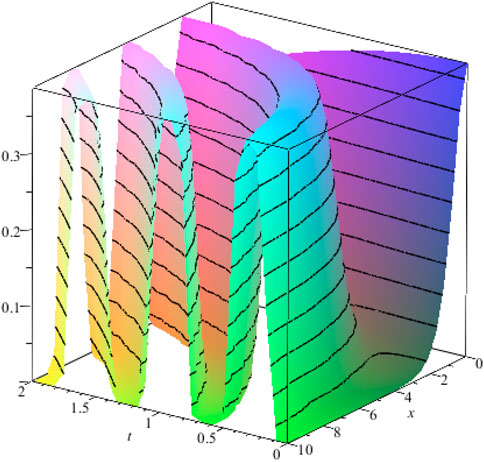
Figure 1. Graph for the solution
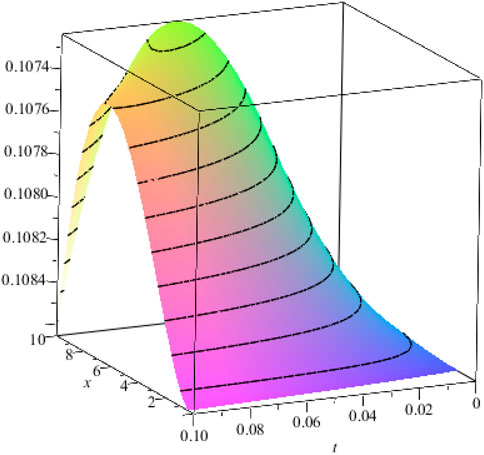
Figure 2. Graph for the solution
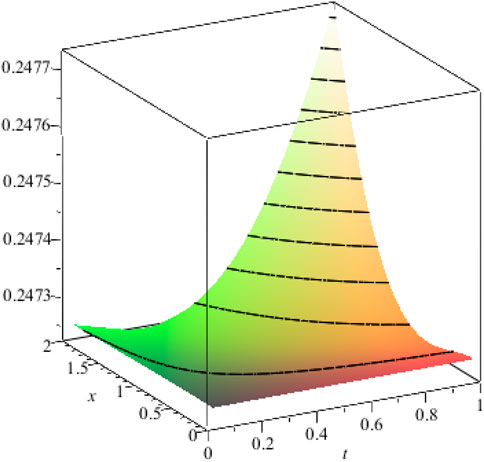
Figure 3. Graph for the solution
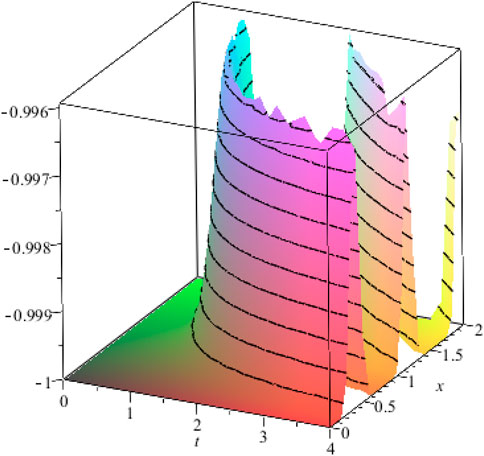
Figure 4. Graph for the solution
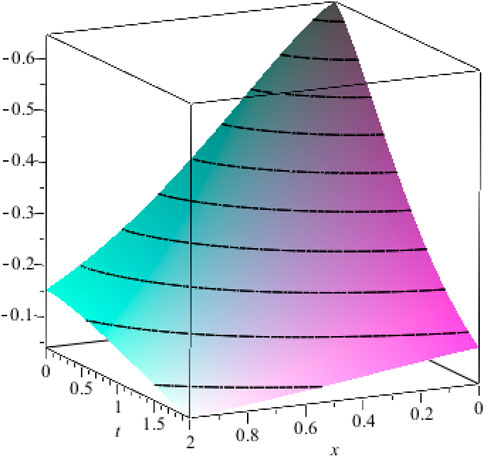
Figure 5. Graph for the solution
6 Conclusion
In this article, we studied the closed-form solution for the nonlinear variable-order fractional evolution equation. The exponential rational function method is considered for VOF-MKE and VOF-BHE, and various new exact traveling wave solutions are successfully obtained for the arbitrary values of the parameters. The closed-form traveling wave solutions are in the form of periodic and other shapes of solitons. The obtained solution might be further beneficial and more achievable on the contrivances of the complex physical phenomena that occur in different fields. The result confirms that the variable-order FDEs are more efficient and feasible. Finally, the considered approach is a more powerful tool to obtain the closed-form traveling wave solutions to VOF-DEs.
Data availability statement
The original contributions presented in the study are included in the article/Supplementary Material; further inquiries can be directed to the corresponding author.
Author contributions
MA: writing–review and editing, investigation, conceptualization, and funding acquisition. UA: writing–original draft, supervision, software, methodology, and investigation. AG: writing–review and editing, validation, resources, methodology, and formal analysis.
Funding
The author(s) declare that financial support was received for the research, authorship, and/or publication of this article. This study is supported via funding from Prince Sattam Bin Abdulaziz University project number (PSAU/2024/R/1445).
Conflict of interest
The authors declare that the research was conducted in the absence of any commercial or financial relationships that could be construed as a potential conflict of interest.
Publisher’s note
All claims expressed in this article are solely those of the authors and do not necessarily represent those of their affiliated organizations, or those of the publisher, the editors, and the reviewers. Any product that may be evaluated in this article, or claim that may be made by its manufacturer, is not guaranteed or endorsed by the publisher.
References
1. Bilal M, Ren J, Younas U. Stability analysis and optical soliton solutions to the nonlinear Schrödinger model with efficient computational techniques. Opt Quant Electron (2021) 53(7):406–19. doi:10.1007/s11082-021-03040-5
3. Haque MM, Akbar MA, Rezazadeh H, Bekir A. A variety of optical soliton solutions in closed-form of the nonlinear cubic quintic Schrödinger equations with beta derivative. Opt Quan Elect (2023) 55(13):1144. doi:10.1007/s11082-023-05470-9
4. Wang KJ, Wang GD. Exact traveling wave solutions for the system of the ion sound and Langmuir waves by using three effective methods. Results Phys (2022) 35:105390. doi:10.1016/j.rinp.2022.105390
5. Islam SR, Arafat SY, Wang H. Abundant closed-form wave solutions to the simplified modified Camassa-Holm equation. J Ocean Eng Sci (2023) 8(3):238–45. doi:10.1016/j.joes.2022.01.012
6. Kumar S, Mann N. Abundant closed-form solutions of the (3+ 1)-dimensional Vakhnenko-Parkes equation describing the dynamics of various solitary waves in ocean engineering. J Ocean Eng Sci (2022). doi:10.1016/j.joes.2022.04.007
7. Kumar S, Kumar A. Abundant closed-form wave solutions and dynamical structures of soliton solutions to the (3+ 1)-dimensional BLMP equation in mathematical physics. J Ocean Eng Sci (2022) 7(2):178–87. doi:10.1016/j.joes.2021.08.001
8. Muhammad T, Hamoud AA, Emadifar H, Hamasalh FK, Azizi H, Khademi M. Traveling wave solutions to the Boussinesq equation via Sardar sub-equation technique. AIMS Math (2022) 7(6):11134–49. doi:10.3934/math.2022623
9. Mohanty SK, Kravchenko OV, Dev AN. Exact traveling wave solutions of the Schamel Burgers’ equation by using generalized-improved and generalized. Results Phys (2022) 33:105124. doi:10.1016/j.rinp.2021.105124
10. Shakeel M, Shah NA, Chung JD. Application of modified exp-function method for strain wave equation for finding analytical solutions. Ain Shams Eng J (2023) 14(3):101883. doi:10.1016/j.asej.2022.101883
11. Almatrafi MB. Abundant traveling waves and numerical solutions for the Novikov-Veselov system with their stability and accuracy. Applicable Anal (2023) 102(8):2389–402. doi:10.1080/00036811.2022.2027381
12. Yao SW, Tariq KU, Inc M, Tufail RN. Modulation instability analysis and soliton solutions of the modified BBM model arising in dispersive medium. Results Phys (2023) 46:106274. doi:10.1016/j.rinp.2023.106274
13. Zhang R, Shakeel M, Turki NB, Shah NA, Tag SM. Novel analytical technique for mathematical model representing communication signals: a new travelling wave solutions. Results Phys (2023) 51:106576. doi:10.1016/j.rinp.2023.106576
14. Hussain A, Usman M, Zaman FD, Ibrahim TF, Dawood AA. Symmetry analysis, closed-form invariant solutions and dynamical wave structures of the Benney-Luke equation using optimal system of Lie subalgebras. Chin J Phys (2023) 84:66–88. doi:10.1016/j.cjph.2023.04.019
15. AlBaidani MM, Ali U, Ganie AH. Nonlinear fractional-order differential equations: new closed-form traveling-wave solutions. Open Phys (2024) 22(1):20230192. doi:10.1515/phys-2023-0192
16. Ali U, Naeem M, Alahmadi R, Abdullah FA, Khan MA, Ganie AH. An investigation of a closed-form solution for non-linear variable-order fractional evolution equations via the fractional Caputo derivative. Front Phys (2023) 11:1114319. doi:10.3389/fphy.2023.1114319
17. Ali U, Ahmad H, Abu-Zinadah H. Soliton solutions for nonlinear variable-order fractional Korteweg–de Vries (KdV) equation arising in shallow water waves. J Ocean Eng Sci (2022). doi:10.1016/j.joes.2022.06.011
18. Akbar MA, Abdullah FA, Islam MT, Al Sharif MA, Osman MS. New solutions of the soliton type of shallow water waves and superconductivity models. Results Phys (2023) 44:106180. doi:10.1016/j.rinp.2022.106180
19. Zaman UHM, Arefin MA, Akbar MA, Uddin MH. Solitary wave solution to the space-time fractional modified Equal Width equation in plasma and optical fiber systems. Results Phys (2023) 52:106903. doi:10.1016/j.rinp.2023.106903
20. Islam MT, Akbar MA, Azad MAK. Traveling wave solutions in closed form for some nonlinear fractional evolution equations related to conformable fractional derivative. AIMS Math (2018) 3(4):625–46. doi:10.3934/math.2018.4.625
21. Zaman UHM, Arefin MA, Akbar MA, Uddin MH. Stable and effective traveling wave solutions to the non-linear fractional Gardner and Zakharov–Kuznetsov–Benjamin–Bona–Mahony equations. Partial Differential Equations Appl Math (2023) 7:100509. doi:10.1016/j.padiff.2023.100509
22. Ali U, Ganie AH, Khan I, Alotaibi F, Kamran K, Muhammad S, et al. Traveling wave solutions to a mathematical model of fractional order (2+ 1)-dimensional breaking soliton equation. Fractals (2022) 30(05):2240124. doi:10.1142/s0218348x22401247
23. Behera S, Mohanty S, Virdi JPS. Analytical solutions and mathematical simulation of traveling wave solutions to fractional order nonlinear equations. Partial Differential Equations Appl Math (2023) 8:100535. doi:10.1016/j.padiff.2023.100535
24. Das N, Ray SS. Exact traveling wave solutions and soliton solutions of conformable M-fractional modified nonlinear Schrödinger model. Optik (2023) 287:171060. doi:10.1016/j.ijleo.2023.171060
25. Alabedalhadi M, Shqair M, Al-Omari S, Al-Smadi M. Traveling wave solutions for complex space-time fractional kundu-eckhaus equation. Mathematics (2023) 11(2):404. doi:10.3390/math11020404
26. Sang X, Zhang Z, Yang H, Han X. Exact traveling wave solutions of the local fractional bidirectional propagation system equations. Fractal and Fractional (2022) 6(11):653. doi:10.3390/fractalfract6110653
27. Bekir A, Güner Ö. Exact solutions of nonlinear fractional differential equations by (G′/G)-expansion method. Chin Phys B (2013) 22(11):110202. doi:10.1088/1674-1056/22/11/110202
28. Yasmin H, Aljahdaly NH, Saeed AM, Shah R. Investigating symmetric soliton solutions for the fractional coupled konno–onno system using improved versions of a novel analytical technique. Mathematics (2023) 11(12):2686. doi:10.3390/math11122686
29. Yasmin H, Alshehry AS, Ganie AH, Mahnashi AM, Shah R. Perturbed gerdjikov–ivanov equation: soliton solutions via backlund transformation. Optik (2024) 298:171576. doi:10.1016/j.ijleo.2023.171576
30. Alshehry AS, Yasmin H, Ganie AH, Ahmad MW, Shah R. Optimal auxiliary function method for analyzing nonlinear system of coupled Schrödinger–KdV equation with Caputo operator. Open Phys (2023) 21(1):20230127. doi:10.1515/phys-2023-0127
31. Yasmin H, Alshehry AS, Ganie AH, Shafee A, Shah R. Noise effect on soliton phenomena in fractional stochastic Kraenkel-Manna-Merle system arising in ferromagnetic materials. Scientific Rep (2024) 14(1):1810. doi:10.1038/s41598-024-52211-3
32. Bekir A, Güner Ö, Cevikel AC. Fractional complex transform and exp-function methods for fractional differential equations. Abstract Appl Anal (2013) 2013:1–8. Hindawi. doi:10.1155/2013/426462
33. Ali U, Mastoi S, Othman WA, Khater MM, Sohail M. Computation of traveling wave solution for a nonlinear variable-order fractional model of modified equal width equation. AIMS Math (2021) 6(9):10055–69. doi:10.3934/math.2021584
34. Tariq KU, Javed R. Some traveling wave solutions to the generalized 3+1-dimensional Korteweg–de Vries–Zakharov–Kuznetsov equation in plasma physics. Math Methods Appl Sci (2023) 46(12):12200–16. doi:10.1002/mma.8596
35. Rezazadeh H, Ullah N, Akinyemi L, Shah A, Mirhosseini-Alizamin SM, Chu YM, et al. Optical soliton solutions of the generalized non-autonomous nonlinear Schrödinger equations by the new Kudryashov's method. Results Phys (2021) 24:104179. doi:10.1016/j.rinp.2021.104179
36. Shahoot AM, Alurrfi KA, Elmrid MO, Almsiri AM, Arwiniya AM. The (G′/G)-expansion method for solving a nonlinear PDE describing the nonlinear low-pass electrical lines. J Taibah Univ Sci (2019) 13(1):63–70. doi:10.1080/16583655.2018.1528663
37. Miah MM, Ali HS, Akbar MA, Seadawy AR. New applications of the two variable (G′/G, 1/G)-expansion method for closed-form traveling wave solutions of integro-differential equations. J Ocean Eng Sci (2019) 4(2):132–43. doi:10.1016/j.joes.2019.03.001
38. Zahran Emad HM, Khater Mostafa MA. Modified extended tanh-function method and its applications to the Bogoyavlenskii equation. Appl Math Model (2016) 40(3):1769–75. doi:10.1016/j.apm.2015.08.018
39. Seadawy AR, Bilal M, Younis M, Rizvi STR, Althobaiti S, Makhlouf MM. Analytical mathematical approaches for the double-chain model of DNA by a novel computational technique. Chaos Solitons Fractals (2021) 144:110669. doi:10.1016/j.chaos.2021.110669
40. Muhammad UA, Salisu A. Exact solutions of the (3+1) generalized fractional nonlinear wave equation with gas bubbles. Int J Sci Res Math Stat Sci (2022) 9(6).
41. Alam MN, Seadawy AR, Baleanu D. Closed-form wave structures of the space-time fractional Hirota–Satsuma coupled KdV equation with nonlinear physical phenomena. Open Phys (2020) 18(1):555–65. doi:10.1515/phys-2020-0179
42. Habib MA, Ali HS, Miah MM, Akbar MA. The generalized Kudryashov method for new closed-form traveling wave solutions to some NLEEs. Aims Math (2019) 4(3):896–909. doi:10.3934/math.2019.3.896
43. Rafiq MN, Majeed A, Inc M, Kamran M. New traveling wave solutions for space-time fractional modified equal width equation with beta derivative. Phys Lett A (2022) 446:128281. doi:10.1016/j.physleta.2022.128281
44. Khatun MA, Arefin MA, Uddin MH, İnç M, Akbar MA. An analytical approach to the solution of fractional-coupled modified equal width and fractional-coupled Burgers equations. J Ocean Eng Sci (2022). doi:10.1016/j.joes.2022.03.016
45. Babajanov B, Abdikarimov F. New exact soliton and periodic wave solutions of the nonlinear fractional evolution equations with additional term. Partial Differential Equations Appl Math (2023) 8:100567. doi:10.1016/j.padiff.2023.100567
46. Ali HS, Habib MA, Miah MM, Miah MM, Akbar MA. Diverse solitary wave solutions of fractional order Hirota-Satsuma coupled KdV system using two expansion methods. Alexandria Eng J (2023) 66:1001–14. doi:10.1016/j.aej.2022.12.021
47. Cao J, Qiu Y, Song G. A compact finite difference scheme for variable order sub-diffusion equation. Commun Nonlinear Sci Numer Simul (2017) 48:140–9. doi:10.1016/j.cnsns.2016.12.022
48. Sun H, Chen W, Li C, Chen Y. Finite difference schemes for variable-order time-fractional diffusion equation. Int J Bifurc Chaos (2012) 22:1250085. doi:10.1142/s021812741250085x
49. Lorenzo CF, Hartley TT. Variable order and distributed order fractional operators. Nonlinear Dyn (2002) 29:57–98. doi:10.1023/a:1016586905654
50. Patnaik S, Hollkamp JP, Semperlotti F. Applications of variable-order fractional operators: a review. Proc R Soc A (2020) 476(2234):20190498. doi:10.1098/rspa.2019.0498
51. Mohapatra SN, Mishra SR, Jena P. Time-fractional differential equations with variable order using RDTM and ADM: application to infectious-disease model. Int J Appl Comput Math (2022) 8(3):138. doi:10.1007/s40819-022-01332-2
52. Rittmann BE, McCarty PL. Variable-order model of bacterial-film kinetics. J Environ Eng Division (1978) 104(5):889–900. doi:10.1061/jeegav.0000825
53. Sweilam NH, Al-Mekhlafi SM, Albalawi AO, Machado JT. Optimal control of variable-order fractional model for delay cancer treatments. Appl Math Model (2021) 89:1557–74. doi:10.1016/j.apm.2020.08.012
Keywords: variable-order Caputo derivative, variable-order fractional modified Kawahara equation, variable-order fractional (2+1)-dimensional Burger hierarchy equation, exponential rational function method, closed-form traveling wave solution
Citation: ALBaidani MM, Ali U and Ganie AH (2024) The closed-form solution by the exponential rational function method for the nonlinear variable-order fractional differential equations. Front. Phys. 12:1347636. doi: 10.3389/fphy.2024.1347636
Received: 01 December 2023; Accepted: 10 June 2024;
Published: 19 July 2024.
Edited by:
Harold Blas, Universidade Federal de Mato Grosso, BrazilReviewed by:
Humaira Yasmin, King Faisal University, Saudi ArabiaJunior Soares, State University of Mato Grosso, Brazil
Copyright © 2024 ALBaidani, Ali and Ganie. This is an open-access article distributed under the terms of the Creative Commons Attribution License (CC BY). The use, distribution or reproduction in other forums is permitted, provided the original author(s) and the copyright owner(s) are credited and that the original publication in this journal is cited, in accordance with accepted academic practice. No use, distribution or reproduction is permitted which does not comply with these terms.
*Correspondence: Umair Ali, umairkhanmath@gmail.com
 Mashael M. ALBaidani1
Mashael M. ALBaidani1